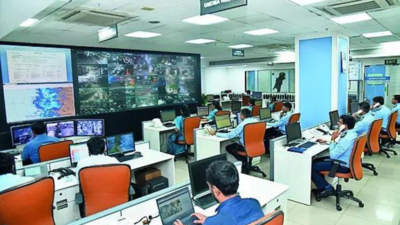Mumbai’s Disaster Management Revolution: From Landlines to AI Technologies | Mumbai News

MUMBAI: Two decades ago, the disaster control room of India’s richest municipality was operating out of a cramped 200-square-foot space -essentially a converted storeroom and garage in the magnificent civic headquarters. “We managed the 2005 flood response from just two rooms,” recalls Mahesh Narvekar, director, BMC disaster management. “There were 4 to 5 landlines, one wireless set, 8-10 staffers and barely any other resources.” Today, the picture couldn’t be more different. The control room spans 7,500 sq ft and is equipped with massive video screens streaming live feeds from 12,000 cameras across the city. On days of heavy rain and flood, the room becomes the hub of the govt, drawing a flurry of high-profile visitors from senior bureaucrats to the chief minister. The turning point for this transformation was the 2005 deluge. That experience made one thing clear, says an official: “Mumbai needed to completely rethink how it prepares for and responds to disasters.”In 2006, the then municipal commissioner Johnny Joseph initiated the first major expansion of the disaster control room, ramping up staff and introducing hotlines. A decade later, in 2017, it underwent another significant upgrade, moving to its current state-of-the-art facility. The control room now operates 60 hunting lines-these allow multiple incoming calls to one dedicated number (1916)-and 60 hotlines, direct dedicated lines connecting to police, fire and other key agencies.Staff strength has also surged: More than 300 personnel are deployed in shifts across the main and ward-level control rooms. Each of the 24 ward rooms are manned by 6-member teams and operate 24/7. Manual logs to monitorsThe biggest change has been in technology. A dedicated command and control software now logs all complaints in real-time, triggering automatic alerts to relevant agencies-from fire brigade to police depending on the emergency. “Earlier, if someone reported a fire, our staff had to manually inform other departments. Today, alerts are sent instantly through automated systems,” the official says. The systems also integrate with GIS platforms, enabling data-driven planning and quicker response coordination.Weather technology has also transformed. In 2005, Mumbai had just 2 automatic weather stations (AWS). Today, it boasts over 120 AWS units, providing real-time data, and Doppler radars, allowing monitoring of rainfall and cyclone threats with greater accuracy.These upgrades have enabled the department to shift from reactive crisis management to pre-emptive action, says an official. Communication runs the gamut of platforms: SMS blasts and app notifications to social media alerts and area-specific messaging. “We now have early warning systems, localised alerts, and social media integration. Citizens no longer wait for announcements-they can access live updates directly,” the official says. The system runs on encrypted digital mobile radios across 5 repeater networks, allowing instant, secure and tamper-proof communication with over 300 key stakeholders, including ward officers, fire chiefs and utility heads, they say. “Communication is the backbone of any disaster response,” said one. The department focus has also expanded from flood response to all sorts of hazards through the year- from fires to pandemic. Earlier, the department only coordinated with the fire brigade; now, they do so with the Navy, the Army, and NRDF. “Today, we are finally in a place where both our systems and our people are equipped to handle the complex urban hazards of the future,” says Narvekar.The road ahead Still, there’s room for improvement as new challenges emerge: The May 26 rain saw 80 new flooding spots spring up-a sign of “how rapidly the city’s landscape and drainage behaviour are changing”.Officials hope another tech upgrade, this time in video analytics, will help manage this unpredictability. The control room already monitors live feeds along with field reports. They plan to introduce an AI system that will make responses even quicker. “If waters start to rise on a certain street, the AI-based software will immediately raise an alert on our control room screens,” the official says. “This allows us to quickly make decisions-whether to send in more manpower, activate additional pumping stations or issue traffic diversions.“







